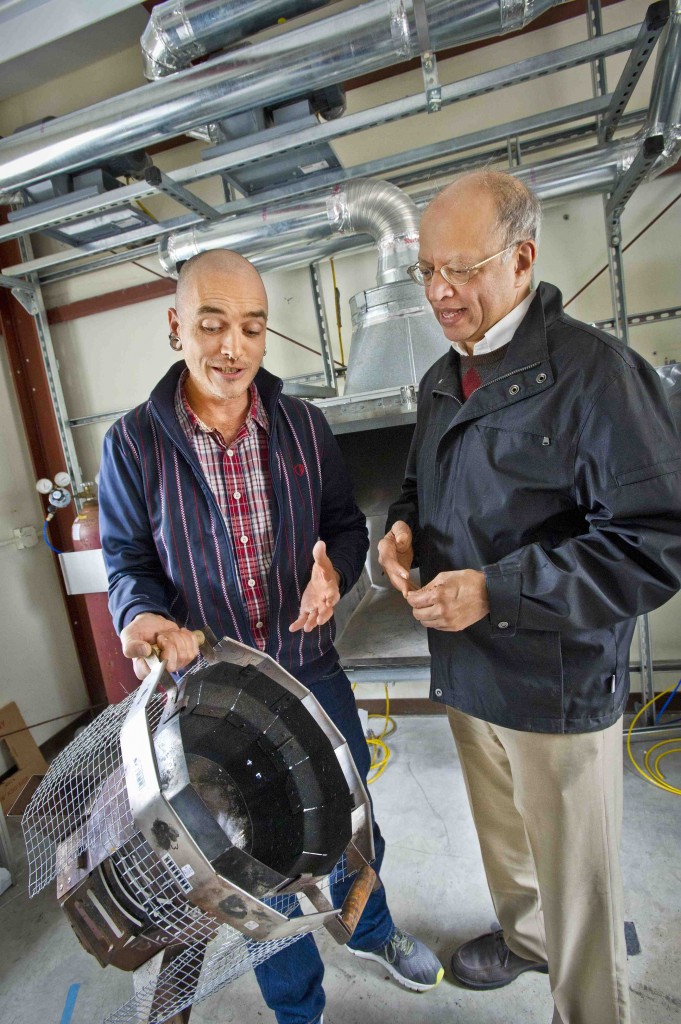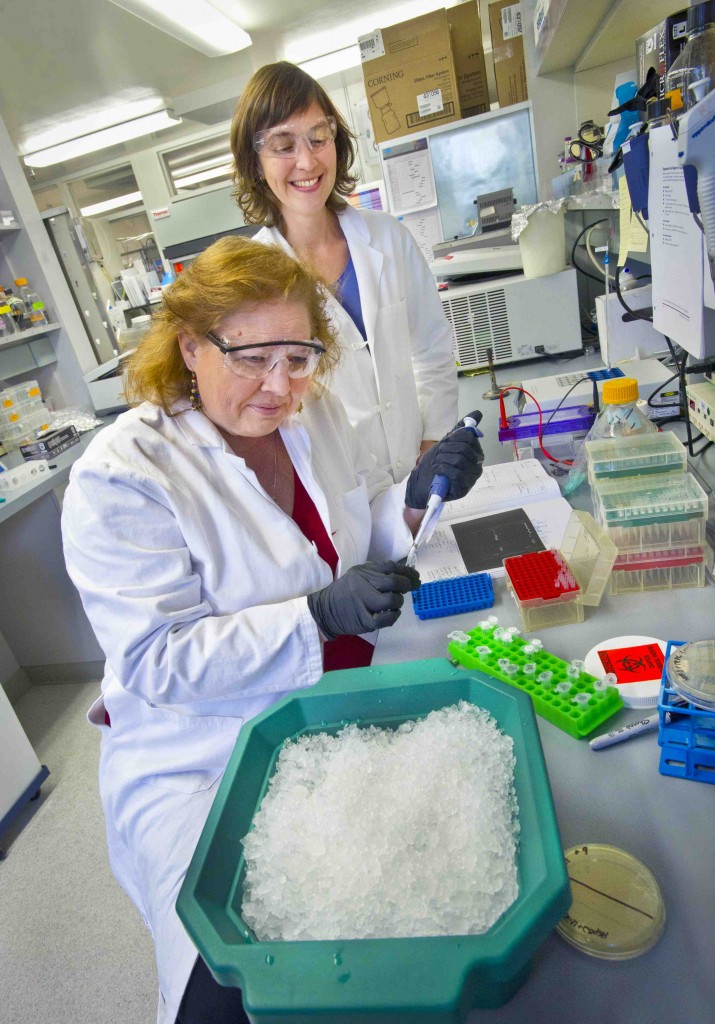High school science teachers face a perennial problem: how to make science real and exciting to their students. But for Berkeley High School teacher Allen Boltz, who spent eight weeks at Lawrence Berkeley National Laboratory working in a research lab, he will be returning to his classroom this fall a near rock star.
“This experience gives a lot of credibility to the teaching profession,” he said. “To my students, me doing research here would be the equivalent to their PE teacher being a professional athlete.”
Through a program called IISME, or Industry Initiatives for Science and Mathematics Education, 12 high school science teachers from throughout the Bay Area spent part of their summer working with Berkeley Lab scientists on ongoing research projects, conducting and designing experiments and helping to collect and analyze data. IISME is just one of the education programs run by the Lab’s Center for Science and Engineering Education (CSEE).

Allen Boltz (left), holding a Berkeley Darfur Stove with a modified heat shield, discusses stove testing with mentor Ashok Gadgil. (Photos by Roy Kaltschmidt/Berkeley Lab)
Boltz, who has a bachelor’s degree in chemistry, was placed with the cookstove research group run by Berkeley Lab scientist Ashok Gadgil, the driving force behind the Berkeley Darfur Stove. Working with other members of the research team, he helped calibrate equipment and perform safety tests to improve the cookstove.
“Working in this lab has made me look at science and appreciate it differently,” Boltz said. “In college lab exercises, there’s a correct outcome, and you have to see if you got it right. When I first started here, I looked at some numbers we got and said, ‘that’s horrible,’ and they said, no, that’s data.”
For his sophomore chemistry class this year, Boltz has developed a lesson plan around cookstove testing to teach concepts such as efficiency, thermodynamics and particulates. He was able to salvage a bunch of old stoves from Haiti that the Berkeley Lab scientists had concluded testing on and will use those in his classroom.
He hopes to also motivate his students to take their investigations one step further and design improvements for the stove. “I think often the creativity of people who haven’t been trained is overlooked,” Boltz said. “Who knows, they might be able to solve a problem.”
Monique de Brito Guedes, who teaches AP environmental science at Berkeley High, says that working at the Lab has helped close what she felt was a gap in her teaching experience. “I didn’t work in the field first, so it’s something I’ve been struggling with, not having that field experience,” she said. “I feel like I’m constantly researching on my own. This is the perfect way for me to keep teaching and get that research experience with experts and scientists in the field.”
She spent the summer working with the HydroEcological Engineering Advanced Decision Support (HEADS) group run by Nigel Quinn, which develops models and tools to manage wetlands in the San Joaquin Basin of California. “I’ve never had much experience with computer modeling, so this has given me such a great opportunity,” de Brito Guedes said. “This will have a big impact on the way I teach. It allows me to bring back ideas of what skills my students will need to be successful in their careers. We call them 21st century skills; they’re not necessarily explicit in our teaching at school.”
She has put together a lesson plan introducing models and systems and was thrilled to get feedback on it from her mentor and another scientist. “My students will be creating their own physical or conceptual model first, then I’ll be scaffolding them to get into a mathematical model and finally they’ll look at a glacial retreat model,” she said. “I plan on not only doing a wetlands unit, but we’ll also look at climate and acid rain pollution through a systems approach.”
Another IISME participant at Berkeley Lab this summer was Autumn Chapman, who teaches freshman biology at Oakland High School. “I’m interested in targeting freshmen because I really feel that’s where we lose a lot of our kids,” she said. “The reason why I teach science is I want them to become literate enough to read the newspaper and know what’s going on and protect their families.”
Chapman worked this summer in the lab of biologist Jill Fuss on a project to understand DNA repair and the role of certain genes involved in a particular set of skin deformities. She plans to bring the experience back to her classroom and have her students use lab tools to actually manipulate DNA and do transformations and understand its real-world implications. “I feel biotech is really important, and I want the kids to see what real science is,” she said. “We have a unit on inherited genetic disease, and a lot of kids can relate to that part.”
The last time Chapman worked in a lab more than 20 years ago, a lot of processes that are now automated were done by hand, such as polymerase chain reactions. “The skills we’re learning here at the Lab are part of our efforts to increase 21st century skills in the classroom and update our science curriculums,” she said. “Developing relationships with the Lab is part of the rationale for giving up our summer vacation time.”
# # #
Lawrence Berkeley National Laboratory (Berkeley Lab) addresses the world’s most urgent scientific challenges by advancing sustainable energy, protecting human health, creating new materials, and revealing the origin and fate of the universe. Founded in 1931, Berkeley Lab’s scientific expertise has been recognized with 13 Nobel prizes. The University of California manages Berkeley Lab for the U.S. Department of Energy’s Office of Science. For more, visit www.lbl.gov.

